

Paideia - Active Learning. A Primer On Using Games To Teach. A Primer On Using Games To Teach by Rosa Fattahi, WizIQ A key element to ensuring any successful pedagogy is student engagement.
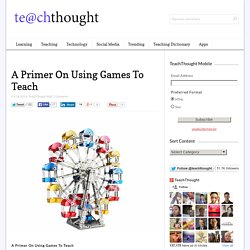
However, keeping students motivated and actively involved can be difficult. Besides the basic challenges of maintaining students’ interest and participation in class, today’s teachers also have to deal with growing numbers of students and the increased distraction from smart phones and other personal devices. One good way to keep students engaged in the learning process is by varying class exercises to include a combination of lectures, individual assignments, group work, computer activities, videos, and other pedagogical tools like games. Why Use Games? In addition to improving student engagement, games contribute to student learning in many ways.
Games make learning more fun and contribute to better peer relationships and a positive classroom atmosphere. Games motivate and interest students, thereby increasing student engagement. What Kinds Of Games? Using Gaming Principles to Engage Students. Game designers understand how to make games memorable and "sticky" in the sense that, even when you aren't playing the game, you're still thinking about solving its problems and puzzles.
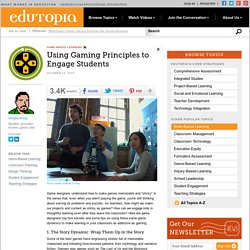
As teachers, how might we make our projects and content as sticky as games? How can we engage kids in thoughtful learning even after they leave the classroom? Here are game designers' top five secrets and some tips on using these same game dynamics to make learning in your classroom as addictive as gaming. 1. The Story Dynamic: Wrap Them Up in the Story Some of the best games have engrossing stories full of memorable characters and following time-honored patterns from mythology and narrative fiction.
In any project-based curriculum, the story is the process. Rather than assessing the final product, find more ways to grade the process. 11 Ways to Make an Inquiry-Based Classroom. How do you turn a traditional, entrenched academic setting into an inquiry-based classroom?
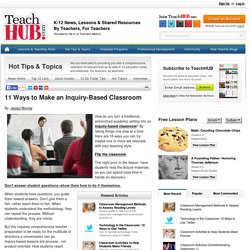
By taking things one step at a time. Here are 15 ways you can try; maybe one or more will resonate with your teaching style. Flip the classroom The night prior to the lesson, have students read the lecture materials so you can spend class time in hands-on discovery. Don't answer student questions--show them how to do it themselves. A quick guide to help you in the classroom management assessment process to... Our 10 favorite technology in the classroom uses of Twitter. Effective classroom activities that will help your students make meaningful... Ways you can bring 9/11 into your classroom space constructively. 10 simple teaching strategies that you can use to keep your struggling students...
When students have questions, you guide them toward answers. But this requires comprehensive teacher preparation to be ready for the multitude of directions a conversation can go. Curious Homework: An Inquiry Project for Students and Parents. Photo credit: iStockphoto International educator Scot Hoffman is a big believer in the power of curiosity to drive learning.
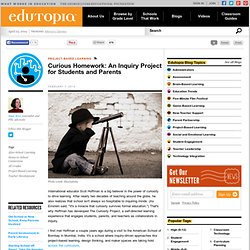
After nearly two decades of teaching around the globe, he also realizes that school isn't always so hospitable to inquiring minds. (As Einstein said, "It's a miracle that curiosity survives formal education. ") Why Kids Need to Move, Touch and Experience to Learn. When students use their bodies in the learning process, it can have a big effect, even if it seems silly or unconnected to the learning goal at hand.
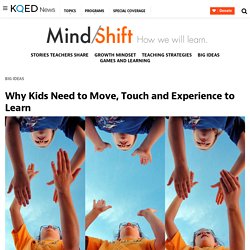
Researchers have found that when students use their bodies while doing mathematical storytelling (like with word problems, for example), it changes the way they think about math. “We understand language in a richer, fuller way if we can connect it to the actions we perform,” said Sian Beilock, professor of psychology at the University of Chicago. Consider this word problem: Two hippos and two alligators are at the zoo. Pete the zookeeper feeds them at the same time. In an experiment on third graders, students were divided into two groups. The answer: “Kids who acted out the story did better on this problem,” Beilock said. Edutopia. Editor's Note: Matt Weyers and co-author Jen Dole, teachers at Byron Middle School in Byron, Minnesota, present the seventh installment in a year-long series documenting their experience of launching a PBL pilot program.
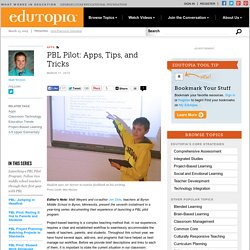
Project-based learning is a complex teaching method that, in our experience, requires a clear and established workflow to seamlessly accommodate the needs of teachers, parents, and students. Throughout this school year, we have found several apps, add-ons, and programs that have helped us best manage our workflow. Before we provide brief descriptions and links to each of them, it is important to state the current situation in our classroom: Students in our classes have individual iPads to use during the school day (they stay at school). Every student has a school-generated Gmail account. Favorite Tool #1: Google Apps The Google Apps suite is an invaluable tool in our classroom.
Favorite Tool #1.1: Doctopus (Google Apps-Related) Favorite Tool #2: Air Server. 5 PBL Best Practices for Redefining the Teacher's Role. Deep learning is messy and complicated.
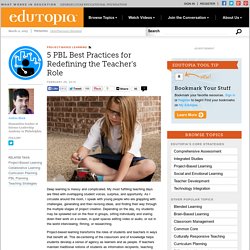
My most fulfilling teaching days are filled with overlapping student voices, surprise, and opportunity. As I circulate around the room, I speak with young people who are grappling with challenges, generating and then revising ideas, and finding their way through the multiple stages of project creation. Driving Question to Facilitate Student Inquiry and Common Core… My Post Fro. Greeting from Napa, California and PBL World which is hosted by BIE (BUCK institute for Education).
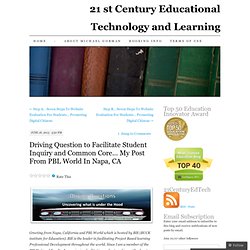
BIE is the leader in facilitating Project Based learning Professional Development throughout the world. Since I am a member of the BIE National Faculty I am enjoying facilitating and networking with educators from across the world at this premier conference. In this post I address the concept of “Driving Questions” I know it is a read you will enjoy and share. I have evn included some amazing links including some to the BUCK Institute (BIE). To ensure you do not miss one of these valuable posts or other resources covering Web 2.0, STEM, 21st century learning, and technology integration please sign up for 21centuryedtech by email or RSS.
Quick Note – I have been getting a lot of request asking if I will make a visit to your school, organization, or conference.